2021 CHRYSLER VOYAGER weight
[x] Cancel search: weightPage 228 of 348
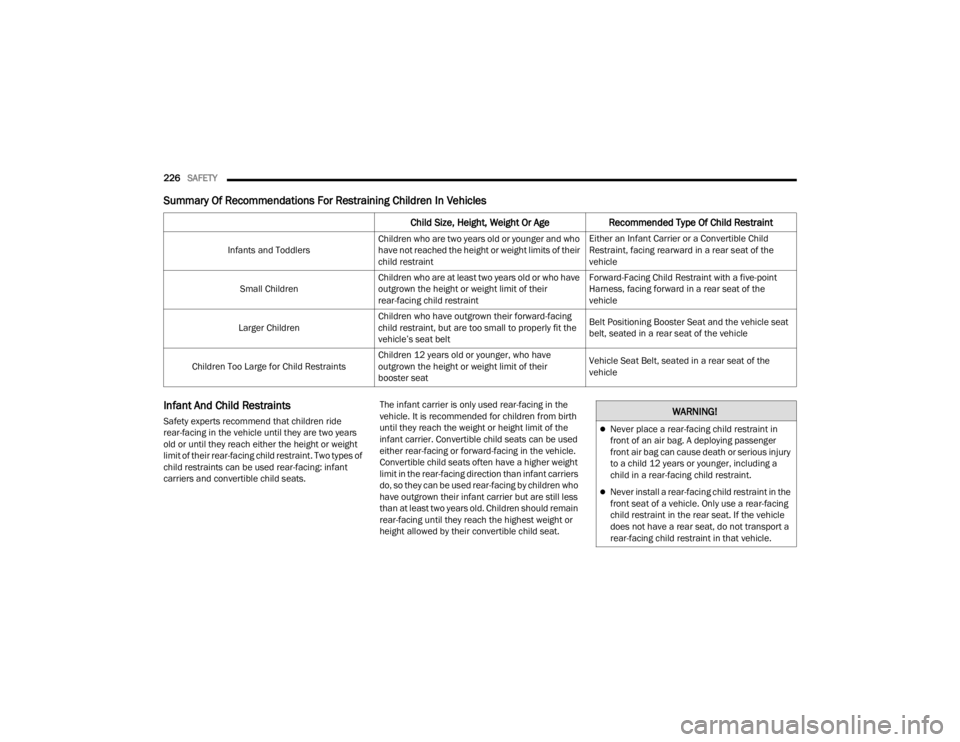
226SAFETY
Summary Of Recommendations For Restraining Children In Vehicles
Infant And Child Restraints
Safety experts recommend that children ride
rear-facing in the vehicle until they are two years
old or until they reach either the height or weight
limit of their rear-facing child restraint. Two types of
child restraints can be used rear-facing: infant
carriers and convertible child seats. The infant carrier is only used rear-facing in the
vehicle. It is recommended for children from birth
until they reach the weight or height limit of the
infant carrier. Convertible child seats can be used
either rear-facing or forward-facing in the vehicle.
Convertible child seats often have a higher weight
limit in the rear-facing direction than infant carriers
do, so they can be used rear-facing by children who
have outgrown their infant carrier but are still less
than at least two years old. Children should remain
rear-facing until they reach the highest weight or
height allowed by their convertible child seat.
Child Size, Height, Weight Or Age
Recommended Type Of Child Restraint
Infants and ToddlersChildren who are two years old or younger and who
have not reached the height or weight limits of their
child restraint Either an Infant Carrier or a Convertible Child
Restraint, facing rearward in a rear seat of the
vehicle
Small Children Children who are at least two years old or who have
outgrown the height or weight limit of their
rear-facing child restraint Forward-Facing Child Restraint with a five-point
Harness, facing forward in a rear seat of the
vehicle
Larger Children Children who have outgrown their forward-facing
child restraint, but are too small to properly fit the
vehicle’s seat belt Belt Positioning Booster Seat and the vehicle seat
belt, seated in a rear seat of the vehicle
Children Too Large for Child Restraints Children 12 years old or younger, who have
outgrown the height or weight limit of their
booster seat Vehicle Seat Belt, seated in a rear seat of the
vehicle
WARNING!
Never place a rear-facing child restraint in
front of an air bag. A deploying passenger
front air bag can cause death or serious injury
to a child 12 years or younger, including a
child in a rear-facing child restraint.
Never install a rear-facing child restraint in the
front seat of a vehicle. Only use a rear-facing
child restraint in the rear seat. If the vehicle
does not have a rear seat, do not transport a
rear-facing child restraint in that vehicle.
21_RUV_OM_EN_USC_t.book Page 226
Page 229 of 348

SAFETY227
Older Children And Child Restraints
Children who are two years old or who have
outgrown their rear-facing convertible child seat
can ride forward-facing in the vehicle.
Forward-facing child seats and convertible child
seats used in the forward-facing direction are for
children who are over two years old or who have
outgrown the rear-facing weight or height limit of
their rear-facing convertible child seat. Children
should remain in a forward-facing child seat with a
harness for as long as possible, up to the highest
weight or height allowed by the child seat.
All children whose weight or height is above the
forward-facing limit for the child seat should use a
belt-positioning booster seat until the vehicle’s
seat belts fit properly. If the child cannot sit with
knees bent over the vehicle’s seat cushion while
the child’s back is against the seatback, they
should use a belt-positioning booster seat. The
child and belt-positioning booster seat are held in
the vehicle by the seat belt.WARNING!
Do not install a rear-facing car seat using a rear
support leg in this vehicle. The floor of this
vehicle is not designed to manage the crash
forces of this type of car seat. In a crash, the
support leg may not function as it was designed
by the car seat manufacturer, and your child may
be more severely injured as a result.
WARNING!
Improper installation can lead to failure of an
infant or child restraint. It could come loose in
a collision. The child could be badly injured or
killed. Follow the child restraint manufac -
turer’s directions exactly when installing an
infant or child restraint.
After a child restraint is installed in the
vehicle, do not move the vehicle seat forward
or rearward because it can loosen the child
restraint attachments. Remove the child
restraint before adjusting the vehicle seat
position. When the vehicle seat has been
adjusted, reinstall the child restraint.
When your child restraint is not in use, secure
it in the vehicle with the seat belt or LATCH
anchorages, or remove it from the vehicle. Do
not leave it loose in the vehicle. In a sudden
stop or accident, it could strike the occupants
or seatbacks and cause serious personal
injury.6
21_RUV_OM_EN_USC_t.book Page 227
Page 231 of 348
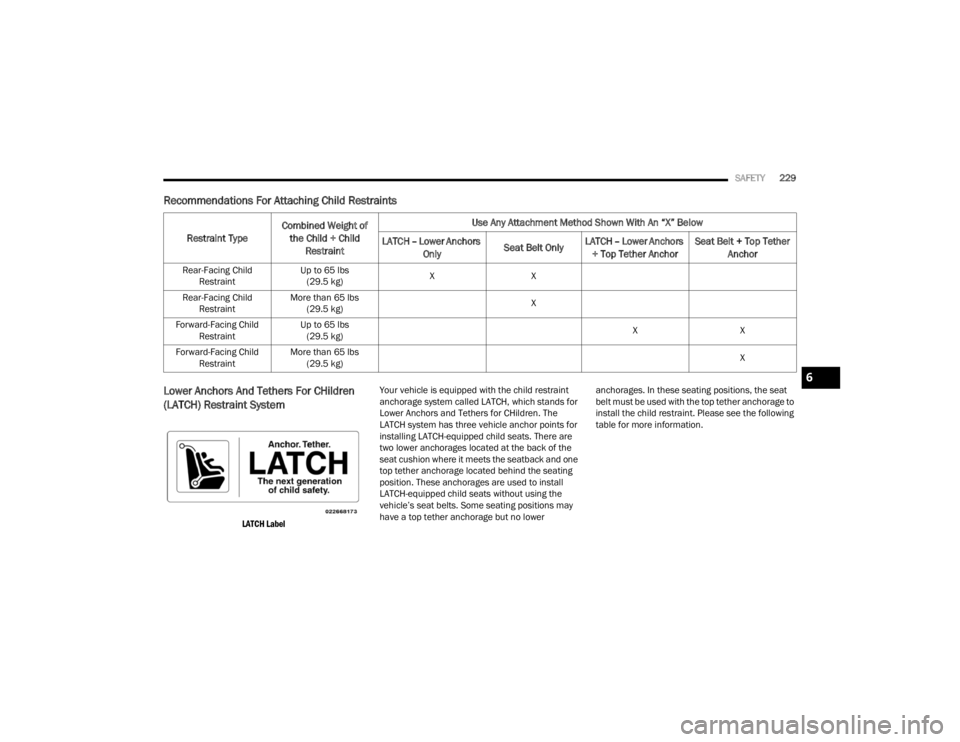
SAFETY229
Recommendations For Attaching Child Restraints
Lower Anchors And Tethers For CHildren
(LATCH) Restraint System
LATCH Label
Your vehicle is equipped with the child restraint
anchorage system called LATCH, which stands for
Lower Anchors and Tethers for CHildren. The
LATCH system has three vehicle anchor points for
installing LATCH-equipped child seats. There are
two lower anchorages located at the back of the
seat cushion where it meets the seatback and one
top tether anchorage located behind the seating
position. These anchorages are used to install
LATCH-equipped child seats without using the
vehicle’s seat belts. Some seating positions may
have a top tether anchorage but no lower
anchorages. In these seating positions, the seat
belt must be used with the top tether anchorage to
install the child restraint. Please see the following
table for more information.
Restraint Type
Combined Weight of
the Child + Child Restraint Use Any Attachment Method Shown With An “X” Below
LATCH – Lower Anchors Only Seat Belt Only LATCH – Lower Anchors
+ Top Tether Anchor Seat Belt + Top Tether
Anchor
Rear-Facing Child Restraint Up to 65 lbs
(29.5 kg) X
X
Rear-Facing Child Restraint More than 65 lbs
(29.5 kg) X
Forward-Facing Child Restraint Up to 65 lbs
(29.5 kg) X
X
Forward-Facing Child Restraint More than 65 lbs
(29.5 kg) X
6
21_RUV_OM_EN_USC_t.book Page 229
Page 233 of 348
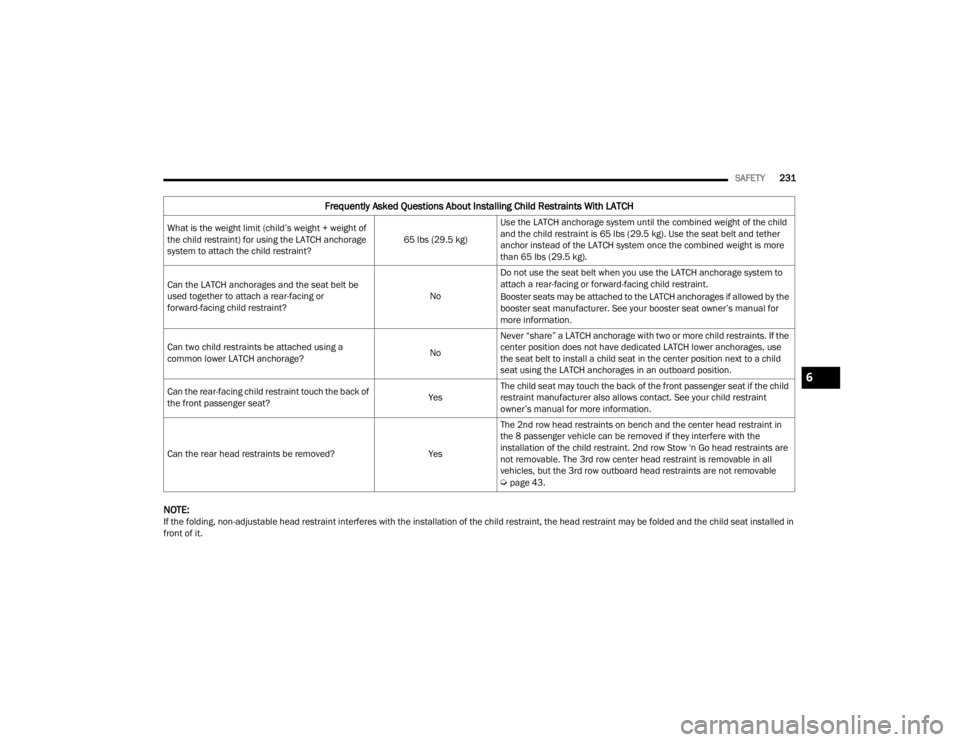
SAFETY231
NOTE:If the folding, non-adjustable head restraint interferes with the installation of the child restraint, the head restraint may be folded and the child seat installed in
front of it.
Frequently Asked Questions About Installing Child Restraints With LATCH
What is the weight limit (child’s weight + weight of
the child restraint) for using the LATCH anchorage
system to attach the child restraint? 65 lbs (29.5 kg)Use the LATCH anchorage system until the combined weight of the child
and the child restraint is 65 lbs (29.5 kg). Use the seat belt and tether
anchor instead of the LATCH system once the combined weight is more
than 65 lbs (29.5 kg).
Can the LATCH anchorages and the seat belt be
used together to attach a rear-facing or
forward-facing child restraint? NoDo not use the seat belt when you use the LATCH anchorage system to
attach a rear-facing or forward-facing child restraint.
Booster seats may be attached to the LATCH anchorages if allowed by the
booster seat manufacturer. See your booster seat owner’s manual for
more information.
Can two child restraints be attached using a
common lower LATCH anchorage? NoNever “share” a LATCH anchorage with two or more child restraints. If the
center position does not have dedicated LATCH lower anchorages, use
the seat belt to install a child seat in the center position next to a child
seat using the LATCH anchorages in an outboard position.
Can the rear-facing child restraint touch the back of
the front passenger seat? YesThe child seat may touch the back of the front passenger seat if the child
restraint manufacturer also allows contact. See your child restraint
owner’s manual for more information.
Can the rear head restraints be removed? YesThe 2nd row head restraints on bench and the center head restraint in
the 8 passenger vehicle can be removed if they interfere with the
installation of the child restraint. 2nd row Stow 'n Go head restraints are
not removable. The 3rd row center head restraint is removable in all
vehicles, but the 3rd row outboard head restraints are not removable
Úpage 43.
6
21_RUV_OM_EN_USC_t.book Page 231
Page 238 of 348
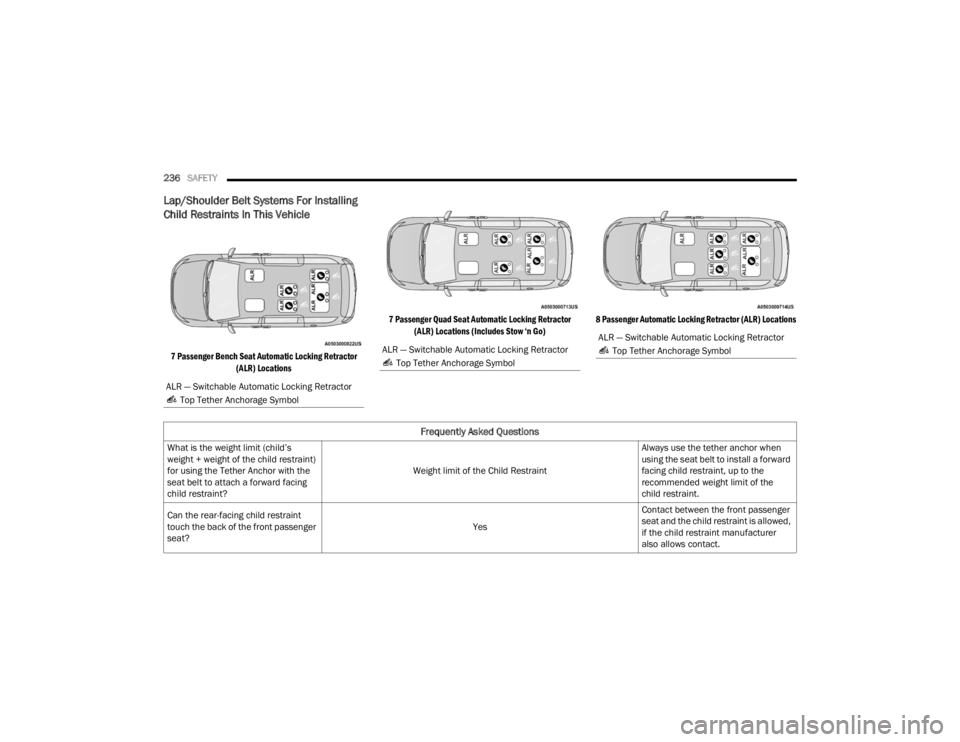
236SAFETY
Lap/Shoulder Belt Systems For Installing
Child Restraints In This Vehicle
7 Passenger Bench Seat Automatic Locking Retractor
(ALR) Locations 7 Passenger Quad Seat Automatic Locking Retractor
(ALR) Locations (Includes Stow ‘n Go) 8 Passenger Automatic Locking Retractor (ALR) Locations
ALR — Switchable Automatic Locking Retractor Top Tether Anchorage SymbolALR — Switchable Automatic Locking Retractor Top Tether Anchorage SymbolALR — Switchable Automatic Locking Retractor Top Tether Anchorage Symbol
Frequently Asked Questions
What is the weight limit (child’s
weight + weight of the child restraint)
for using the Tether Anchor with the
seat belt to attach a forward facing
child restraint? Weight limit of the Child RestraintAlways use the tether anchor when
using the seat belt to install a forward
facing child restraint, up to the
recommended weight limit of the
child restraint.
Can the rear-facing child restraint
touch the back of the front passenger
seat? YesContact between the front passenger
seat and the child restraint is allowed,
if the child restraint manufacturer
also allows contact.
21_RUV_OM_EN_USC_t.book Page 236
Page 308 of 348
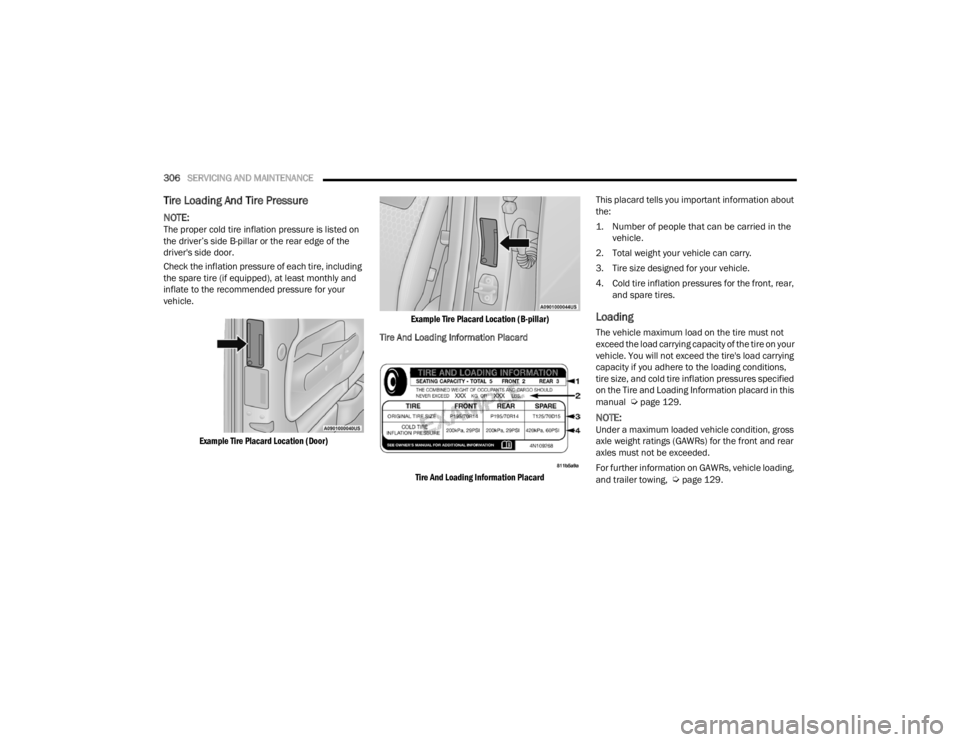
306SERVICING AND MAINTENANCE
Tire Loading And Tire Pressure
NOTE:The proper cold tire inflation pressure is listed on
the driver’s side B-pillar or the rear edge of the
driver's side door.
Check the inflation pressure of each tire, including
the spare tire (if equipped), at least monthly and
inflate to the recommended pressure for your
vehicle.
Example Tire Placard Location (Door) Example Tire Placard Location (B-pillar)
Tire And Loading Information Placard
Tire And Loading Information Placard
This placard tells you important information about
the:
1. Number of people that can be carried in the
vehicle.
2. Total weight your vehicle can carry.
3. Tire size designed for your vehicle.
4. Cold tire inflation pressures for the front, rear, and spare tires.
Loading
The vehicle maximum load on the tire must not
exceed the load carrying capacity of the tire on your
vehicle. You will not exceed the tire's load carrying
capacity if you adhere to the loading conditions,
tire size, and cold tire inflation pressures specified
on the Tire and Loading Information placard in this
manual
Úpage 129.
NOTE:Under a maximum loaded vehicle condition, gross
axle weight ratings (GAWRs) for the front and rear
axles must not be exceeded.
For further information on GAWRs, vehicle loading,
and trailer towing,
Úpage 129.
21_RUV_OM_EN_USC_t.book Page 306
Page 309 of 348
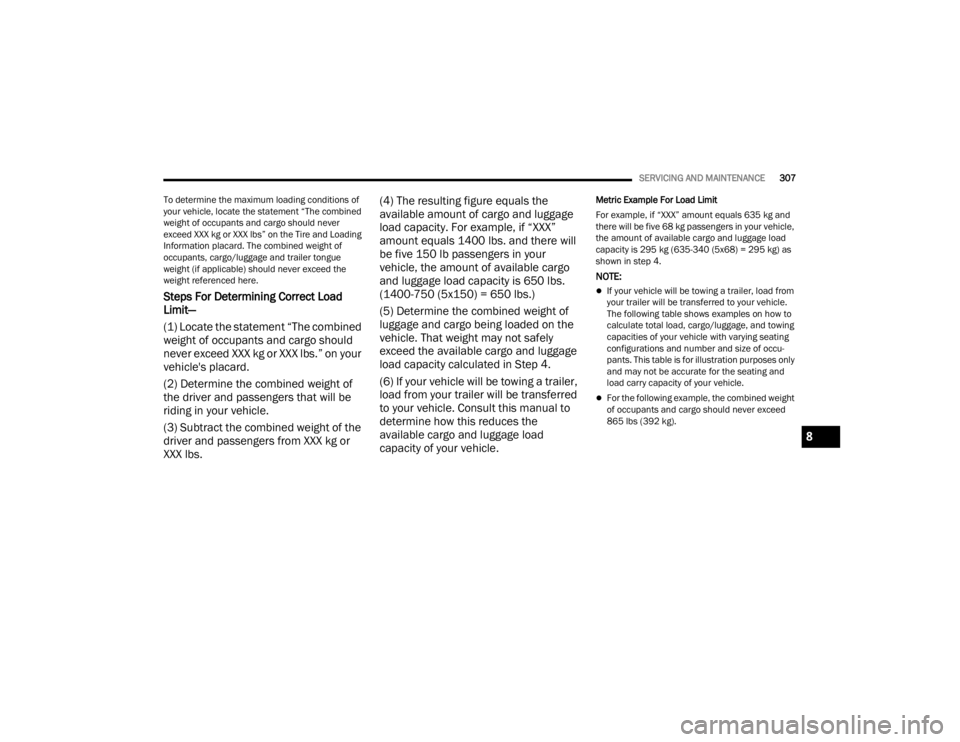
SERVICING AND MAINTENANCE307
To determine the maximum loading conditions of
your vehicle, locate the statement “The combined
weight of occupants and cargo should never
exceed XXX kg or XXX lbs” on the Tire and Loading
Information placard. The combined weight of
occupants, cargo/luggage and trailer tongue
weight (if applicable) should never exceed the
weight referenced here.
Steps For Determining Correct Load
Limit—
(1) Locate the statement “The combined
weight of occupants and cargo should
never exceed XXX kg or XXX lbs.” on your
vehicle's placard.
(2) Determine the combined weight of
the driver and passengers that will be
riding in your vehicle.
(3) Subtract the combined weight of the
driver and passengers from XXX kg or
XXX lbs. (4) The resulting figure equals the
available amount of cargo and luggage
load capacity. For example, if “XXX”
amount equals 1400 lbs. and there will
be five 150 lb passengers in your
vehicle, the amount of available cargo
and luggage load capacity is 650 lbs.
(1400-750 (5x150) = 650 lbs.)
(5) Determine the combined weight of
luggage and cargo being loaded on the
vehicle. That weight may not safely
exceed the available cargo and luggage
load capacity calculated in Step 4.
(6) If your vehicle will be towing a trailer,
load from your trailer will be transferred
to your vehicle. Consult this manual to
determine how this reduces the
available cargo and luggage load
capacity of your vehicle.
Metric Example For Load Limit
For example, if “XXX” amount equals 635 kg and
there will be five 68 kg passengers in your vehicle,
the amount of available cargo and luggage load
capacity is 295 kg (635-340 (5x68) = 295 kg) as
shown in step 4.
NOTE:
If your vehicle will be towing a trailer, load from
your trailer will be transferred to your vehicle.
The following table shows examples on how to
calculate total load, cargo/luggage, and towing
capacities of your vehicle with varying seating
configurations and number and size of occu
-
pants. This table is for illustration purposes only
and may not be accurate for the seating and
load carry capacity of your vehicle.
For the following example, the combined weight
of occupants and cargo should never exceed
865 lbs (392 kg).
8
21_RUV_OM_EN_USC_t.book Page 307
Page 337 of 348

335
Fluid Level Checks Brake
........................................................ 289Engine Oil.................................................. 276Fluid, Brake................................................... 327Fog Lights................................................. 53, 54Fold In Floor (Stow ‘n Go) Seating.................... 37Fold-Flat Seats................................................. 28Forward Collision Warning............................. 196Freeing A Stuck Vehicle................................. 267Front Position Light........................................ 301Fuel............................................................... 323Additives................................................... 325Clean Air.................................................... 324Ethanol...................................................... 324Filler Cap (Gas Cap)................................... 129Gasoline.................................................... 323Materials Added........................................ 325Methanol................................................... 324Octane Rating................................. 323, 326Requirements........................................... 323Specifications............................................ 326Tank Capacity............................................ 326Fuses............................................................. 290
G
Garage Door Opener (HomeLink).................... 50Gas Cap (Fuel Filler Cap)............................... 129Gasoline, (Fuel)............................................. 323Gasoline, Clean Air........................................ 324Gasoline, Reformulated................................. 324
Gear Ranges................................................. 115Glass Cleaning.............................................. 321Gross Axle Weight Rating.............................. 131Gross Vehicle Weight Rating......................... 131GVWR............................................................ 129
H
HazardDriving Through Flowing, Rising,Or Shallow Standing Water
.................. 140Hazard Warning Flashers.............................. 245Head Restraints............................................... 43Headlights....................................................... 53Cleaning................................................... 319High Beam/Low Beam Select Switch.......... 53Lights On Reminder.............................. 53, 54Passing................................................. 53, 54Switch.......................................................... 53Time Delay................................................... 53Heated Mirrors................................................. 48Heated Seats................................................... 43Heater, Engine Block.................................... 110Hill Start Assist.............................................. 190HitchesTrailer Towing........................................... 132HomeLink (Garage Door Opener)..................... 50Hood Prop........................................................ 80Hood Release.................................................. 80Hook, Coat....................................................... 74
I
Ignition.............................................................15Switch..........................................................15Inside Rearview Mirror........................... 48, 245Instrument Cluster...........................................88Descriptions.............................................. 103Display.........................................................88Display Controls...........................................89KeySense Message.....................................90Menu Items.................................................91Instrument Panel Lens Cleaning................... 321Interior And Instrument Lights.........................55Interior Appearance Care.............................. 320Interior Lights...................................................55Intermittent Wipers (Delay Wipers)..................57Introduction....................................................... 7
J
Jack Location................................................ 250Jack Operation.............................................. 249Jump Starting................................................ 262
K
Key Fob............................................................12Arm The System...........................................19Disarm The Alarm........................................19Programming Additional Key Fobs...............14Key Fob Battery Service
(Remote Keyless Entry)....................................13
11
21_RUV_OM_EN_USC_t.book Page 335